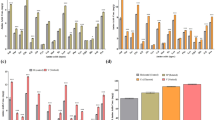Summary
A device used for simulated weightless studies is described and is called the Nogravatron. The Nogravatron apparatus produces simulated weight-lessness by rotating seedlings simultaneously at the rate of 0.25 rpm and 1.0 rpm in two axes perpendicular to each other. Atlas barley seedlings grown on the apparatus grew at rates different from that of stationary controls. Coleoptile elongation in rotated barley was not inhibited by light during the first 55 hours of rotation treatment whereas stationary controls were photoinhibited. After 55 hours the growth of rotated coleoptiles was inhibited by light. The coleoptiles did not show movements and were oriented along the longitudinal axis of the seed. Roots also did not show geotropic movements but the growth direction was affected by the proximity of other roots. Coleoptiles rotated in dark were significantly longer than stationary controls on the third and fourth day but not so on the fifth day and later. Coleoptiles rotated in light were about 35 percent longer than the stationary coleoptiles by the third day and maintained this significant difference to the end of the experiment.
Similar content being viewed by others
Literature
Bertsch, W. F., and W. S. Hillman: The photoinhibition of growth in etiolated stem segments. 1. Growth caused by sugar in Pisum. Amer. J. Bot. 48 (6), 504–511 (1961).
Brain, E. D.: Studies in the effects of prolonged rotation of plants on a horizontal klinostat. 1. Growth rate. New Phytologist 34, 97–112 (1935).
Gerathewohl, S. J.: Zero-G devices and weightlessness simulators. Nat. Acad. Sci.-Nat. Res. Council, Publ. No 781, (1960).
Hoshizaki, T., and K. C. Hamner: An unusual stem bending response of Xanthium pensylvanicum to horizontal rotation. Plant Physiol. 37 (4), 453–459 (1962).
Larsen, P.: The development of geotropic and spontaneous curvatures in roots. Physiol. Plantarum (Kbh.) 10, 127–163 (1957).
Lvon, C. J.: Measurement of geotropic sensitivity of seedlings. Science 133 (3447), 194–195 (1961).
Pollack, J. R. A.: The nature of the malting process. In: Barley and Malt (ed. A. H. Cook), p. 303–388. New York: Academic Press 1961.
Sidorov, B. N., and N. N. Sokolov: Effect of space flight conditions on the seeds of Allium fistulosum (winter onion) and Nigella domascena (ranunculus). Iskusstvennye sputniki Zemli. Akad. Nauk SSSR 10, 93–95 (1961).
Talts, J.: Zur Kenntnis der Klinostatenwirkung. I. Einfluß der Rotations-geschwindigkeit auf die geotropische Erregbarkeit der Keimwurzeln von Lupinus albus. Planta (Berl.) 16, 178–194 (1932).
Westing, A. H.: Geotropism: Its orienting force. Science 144 (3642), 1342–1343 (1964).
Zimmermann, W.: Beiträge zur Kenntnis der Georeaktionen. Jb. wiss. Bot. 66, 631–678 (1927).
Author information
Authors and Affiliations
Additional information
Supported in part by NASA Grant NsG 538-63 and by Air Force Office of Scientific Research Office of Aerospace Research, United States Air Force, Contract No. AF 49 (638)-1387.
Rights and permissions
About this article
Cite this article
Hoshizaki, T., Adey, W.R. & Hamner, K.C. Growth responses of barley seedling to simulated weightlessness induced by two-axis rotation. Planta 69, 218–229 (1966). https://doi.org/10.1007/BF00384874
Received:
Issue Date:
DOI: https://doi.org/10.1007/BF00384874




